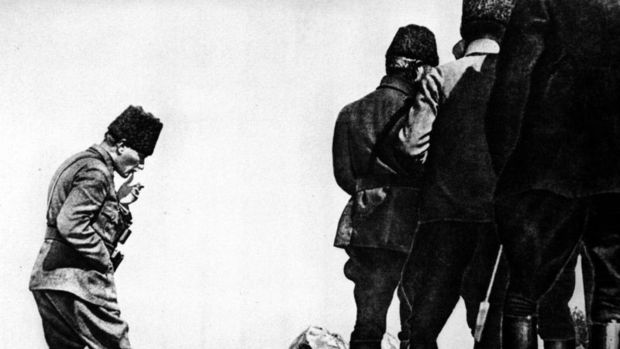The day the greatest heroic epic in history was written: August 30
Happy 101st anniversary of August 30th Victory Day..Today is the anniversary of the Great Victory that followed the Great Offensive that started on July 26, 1922 and lasted for 4 days. Gazi Mustafa Kemal Atatürk said of the Great Victory that it was “the most important turning point in Turkish history.” Under the command of the Great Leader Mustafa Kemal Atatürk, the Turkish army wrote one of the greatest heroic epics in world history in the Great Offensive and the Battle of the Commander-in-Chief Field that started on July 26, 1922 and ended with a great victory on August 30. In 1919, after World War I, the Allied Powers began to invade Anatolia with various excuses based on the provisions of the Armistice of Mudros, and the Turkish nation, whose army's ammunition was taken away, was tried to be put in a difficult situation. During the occupation days narrated by Halide Edip Adıvar in her book "The Fire Test of the Turk", the Allied fleet settled in Istanbul, the French in Adana, the British in Urfa, Maraş, Samsun and Merzifon, and the Italians in Antalya and the southwest of Anatolia. On May 15, 1919, with the permission of the Allied Powers, the Greek Army landed in Izmir. In the face of this situation, the Turkish nation, with the "consciousness of being a nation" it has shown throughout history, started the Kuvayımilliye movement against the occupations. There were two options; either surrender to the occupying forces or a country that had been destroyed and burned would rise again and rise from its ashes. Upon the opening of the Turkish Grand National Assembly in 1920, the occupying forces concentrated all their oppressive policies on Atatürk and his comrades-in-arms, and activity began especially on the Western Front. The Greek army came as far as Polatlı in 1921. Preparations were being made in Polatlı for the world's longest pitched battle. "There is no line of defense, there is a surface defense" The Battle of Sakarya, which was the pitched battle between the Turkish army and the Greek army on the Sakarya coast, began on August 23. In the battle that continued day and night from that date on, Mustafa Kemal Pasha implemented a new war strategy and ordered his armies, "There is no line of defense, there is a surface defense. That surface is the entire homeland. Every inch of the homeland cannot be abandoned unless it is soaked with the blood of its citizens." The Turkish soldiers defended their homeland with all their might by obeying this order. This relentless struggle lasted for 22 days and 22 nights with all its might. The Turkish army, which continued its attack along the entire front, cleared the Greek forces from the east of the Sakarya River on September 13, 1921. The Battle of Sakarya took its place in history as one of the turning points when the Turkish nation switched from a defensive position to an offensive position. After a preparation period of about a year with the aim of completely expelling the enemy army from the country, on August 26, 1922, Commander-in-Chief Mustafa Kemal Pasha gave the operation order that started the Great Offensive. As dawn broke on August 26 in Kocatepe... Commander-in-Chief Mustafa Kemal took his place in Kocatepe, which remained within the borders of Afyonkarahisar, on the morning of August 26 to direct the battle with Chief of General Staff Fevzi Pasha (Çakmak) and Western Front Commander İsmet Pasha (İnönü). Continuing the operation that started at dawn with artillery fire, Turkish soldiers launched an attack at first light, captured Tınaztepe and pushed the enemy away from Belentepe and Kalecik Sivrisi. On the first day of the offensive, 1st Army units captured the enemy's first line positions in the 15-kilometer area between Büyük Kaleciktepe and Çiğiltepe. The 5th Cavalry Corps successfully attacked the enemy’s rear transport lines, while the 2nd Army continued its reconnaissance mission on the front without fail. The Turkish army launched another offensive on all fronts on the morning of August 27, and Afyonkarahisar was liberated from enemy occupation by the 8th Division on the same day. The offensive, which was successfully carried out on August 28 and 29, resulted in the neutralization of the enemy’s 5th Division. The commanders, who assessed the situation on the night of August 29, agreed that immediate action should be taken and the offensive should be concluded in a short time, and the necessary measures were taken to ensure that the plan was implemented without delay on August 30. A Great Victory and a Broken Cart On the eve of the most important victory won by the Turkish army in the War of Independence, on the morning of August 30, Commander-in-Chief Mustafa Kemal Pasha gave the order to launch an attack to the troops in Zafertepe Çalköy, now a town in the Altıntaş district of Kütahya. The victory was achieved when the Turkish army under the command of the Great Leader Mustafa Kemal Atatürk completely surrounded and destroyed the Greek troops on both sides of the Alliören, Keciler, and Kızıltaş Creek road in Dumlupınar in the Battle that started on August 26. Some Greek troops, General Trikopis, General Diyenis and many Greek commanders escaped from the open area in the Kızıltaş Creek region. The day after the Great Victory, on August 31, Commander-in-Chief Mustafa Kemal placed a map of the battlefields on a broken oxcart in the garden of a house in Zafertepe Çalköy, evaluated the situation with Fevzi Pasha and İsmet Pasha, and agreed on entering İzmir to prevent the Greeks from taking up defensive positions again and to defeat them. "Armies, your first target is the Mediterranean, forward!" Mustafa Kemal Pasha, in the declaration he published to be read to all officers and men on the Western Front in Dumlupınar on September 1st after the Great Victory, included the following statements: "Armies of the Grand National Assembly of Turkey, in the Afyonkarahisar-Dumlupınar Great Field Battle, you destroyed the fundamental existence of a cruel and proud army in an incredibly short time. You proved that you are worthy of the sacrifices of our great and distinguished nation. Our owner, the great Turkish nation, is right to trust in its future. I see and follow your successes and sacrifices on the battlefields closely. I will not give up and will constantly fulfill my duty to mediate the conveyance of our nation's praise to you. I ordered the Front Command to make a proposal for rewards to the Commander-in-Chief. I request all my friends to proceed by taking into account that there will be other field battles in Anatolia and to continue the competition with all their might by using the power of their minds and the resources of their patriotism. Armies, your first target is the Mediterranean, forward!" In accordance with this order, the Turkish army, advancing in three wings, took back Gediz and Uşak on September 1, Eskişehir on September 2, Balıkesir and Bilecik on September 6, Aydın on September 7, and Manisa on September 8. The Turkish army, which drove the Greek army into the sea in İzmir on September 9, carried out Mustafa Kemal Pasha's order with great success. With the sorrow of not being able to fulfill his duty... One of the most important events that remain in mind from the Great Offensive was the suicide of the 57th Division Commander, Colonel Reşat Bey, by shooting himself on August 27, due to the half-hour delay in taking Çiğiltepe. When Mustafa Kemal Pasha called the 57th Division Command, which was fighting on the ridges of Çiğiltepe, on the phone again, he was told that Colonel Reşat Bey had committed suicide and he wrote, "In half an hour, that The note read: "Although I promised you to take the position, I could not keep my promise and therefore I cannot live." Çiğiltepe was liberated from enemy soldiers 15 minutes after the death of Colonel Reşat Bey. "The foundation of the Turkish Republic was strengthened here" Two years after the Great Victory, on August 30, 1924, the Great Leader Atatürk came to Zafertepe Çalköy to attend the groundbreaking ceremony of the Martyr Flag-bearer Mehmetçik Monument. Reminding the participants of the ceremony of two years ago, Atatürk described the Great Victory with the following sentences: "The Afyonkarahisar-Dumlupınar Battle and its final part, the August 30 Victory, are the most important turning points in Turkish history. Our national history is full of very great and very bright victories, but I do not remember a battle as decisive as the victory won by the Turkish nation here, and as decisively effective in giving a new step not only to our history but also to world history. It is obvious that the foundation of the new Turkish state, the young Turkish Republic, was strengthened here, and its immortal life was crowned here. The Turkish blood shed in this area, the souls of the martyrs flying in these skies are the immortal protectors of our state and our Republic. With the victory won here, the Turkish nation, with the power and will it revealed, has once again put this certain truth into the heart of history with a steel pen." August 30, which was first celebrated as Victory Day in 1926, is celebrated every year with various events throughout the country and in the TRNC.


